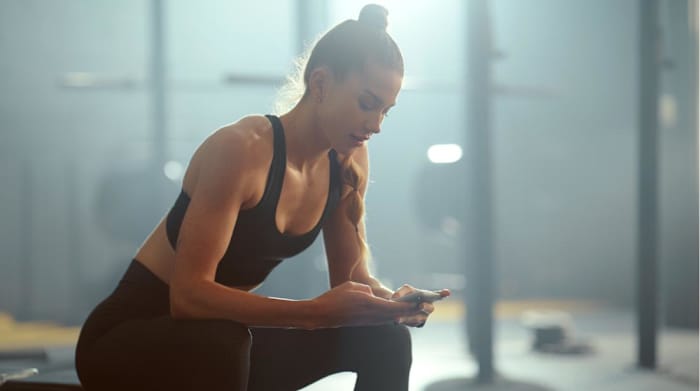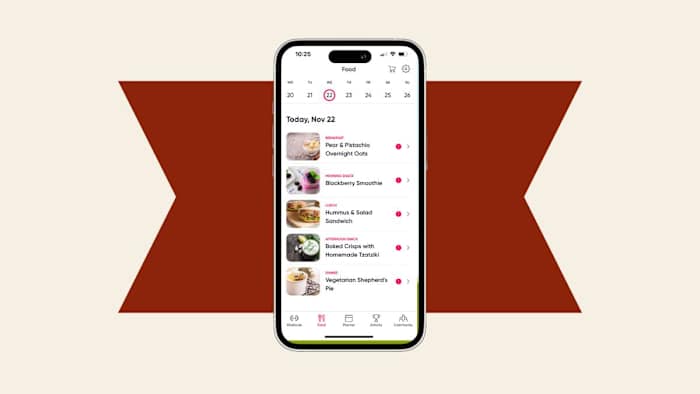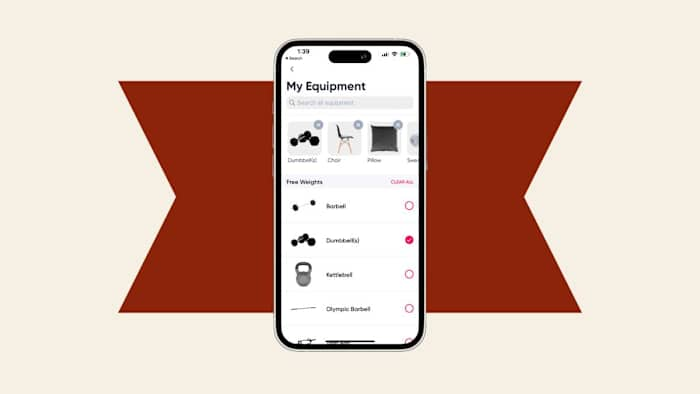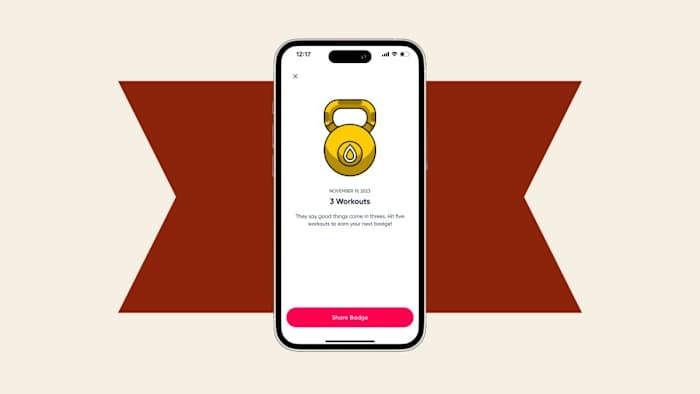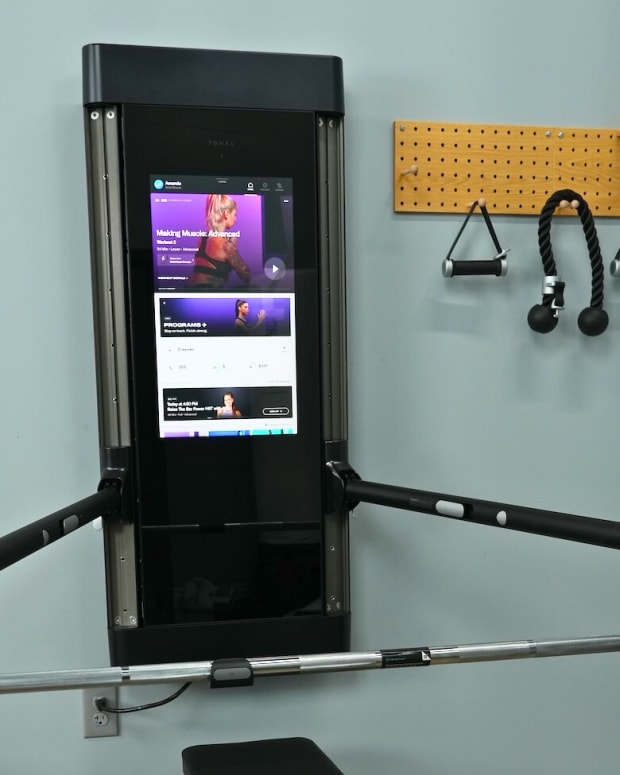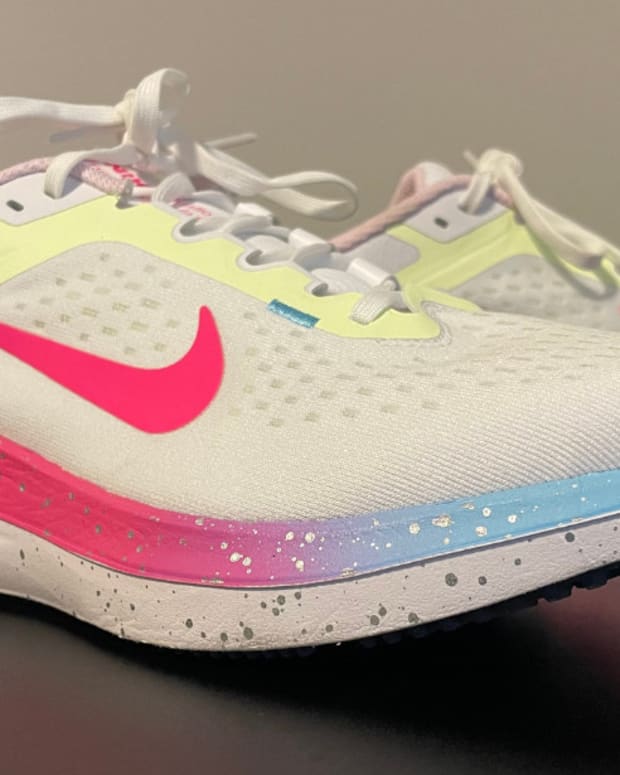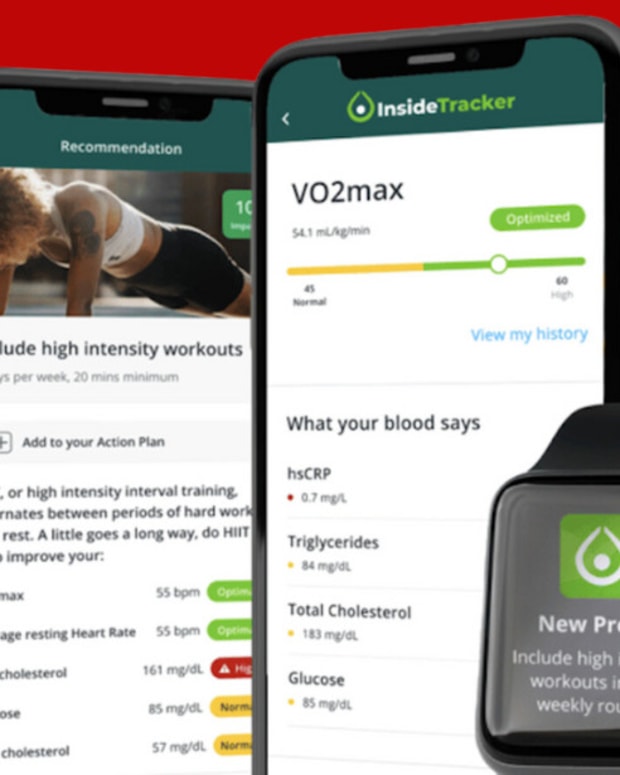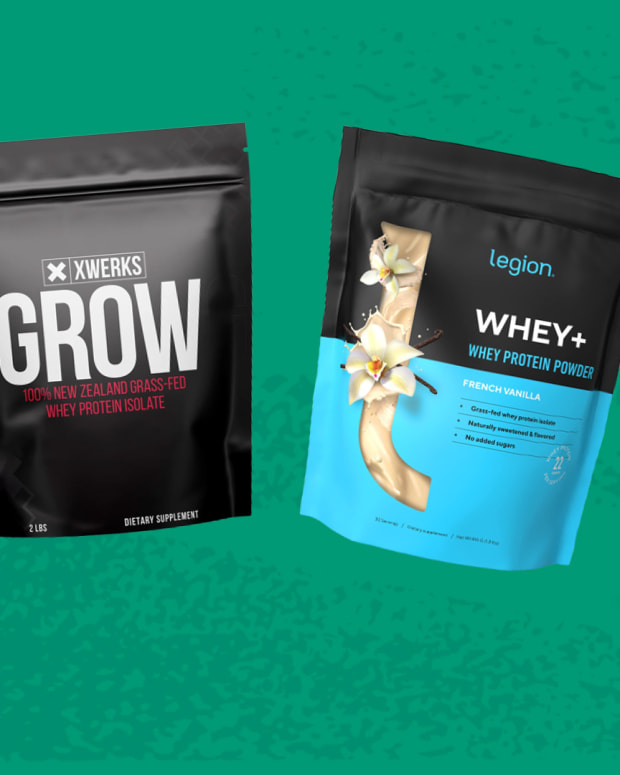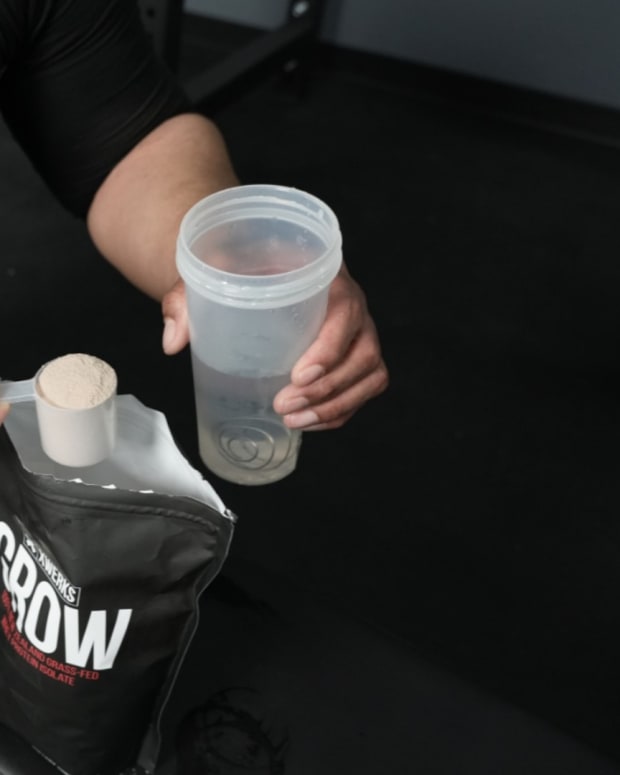The products featured in this article have been independently reviewed. When you buy something through the retail links on this page, we may earn commission at no cost to you, the reader. Sports Illustrated editorial staff are not involved in the creation of this content. Learn more here.
Key Features:
- Sweat, from fitness influencer Kayla Itsines, is a unique workout app that breaks exercise programs down move by move to follow at your own leisure
- The app stands out for its woman-focused narrative, user-friendly interface, comprehensive meal planning and gym-friendly workouts
- $79.99 annual subscription
The Sweat app by fitness guru Kayla Itsines is a unique workout app designed to help self-starters reach their fitness goals. The app's segmented workout programs can be watched while listening to music on the same device, and range from high-intensity workouts, to strength conditioning and yoga, with flexibility for all fitness levels.
Ultimately, after testing for several weeks, here’s what I really liked about Sweat: In the grand theater of workout apps like Peloton and Nike Training Club, Sweat steals the spotlight by providing a uniquely woman-focused narrative and community, positioning the program as one of the best workout apps for women. Other pros include the app's user-friendly interface, comprehensive meal planning and ability to easily follow workouts at the gym.
In this Sweat App review, I'll explain the app, including my personal experience: What I liked, what I didn't and who can most benefit from the budget-friendly ($79.99 annually is a pretty sweet deal) workout app.
What Is Sweat?
Sweat is a mobile app that provides a blueprint to achieve results when working out at the gym or home. The app’s original architect is Kayla Itsines, who engineered the app’s flagship BBG program (short for Bikini Body Guide), which you can still take and goes by the name “High Intensity.” Today, Itsines is joined by several other trainers on their app who lead their own programs—at the time of this review, more than 20 programs populate the app.
The app has a user-friendly interface and an emphasis on community, helping you foster a supportive network on your fitness journey. Another key feature of Sweat is its meal planning functionality, ensuring a well-rounded approach to health by adding nutritional guidance—key to any weight loss strategy, if that’s your goal—with workout routines.
Plus, in a landscape populated by uber-macho brands and workouts, Sweat stands apart not only for its features but also its purpose: The app describes itself as a fitness journey "designed by women, for women.”
How Sweat Works
Signing up
Getting started with an online workout program like Sweat is easy; all you need is your phone and an internet connection. Your Sweat journey can begin in either the Apple App Store or Google Play Store. From there, you create a user profile and set your goals and preferences for working out. Goals can range from weight loss and muscle gains to just general fitness improvement. Based on your profile, the app will suggest personalized workout programs, which vary in intensity, duration and focus. Once you choose your program—you can go with the app’s recommendation or go rogue—the app will schedule classes in the Planner.
Community support
Sweat places a strong emphasis on community support. Users can connect with others worldwide who are on similar fitness journeys. The community provides a platform for sharing experiences, tips and encouragement.
Meal planning and progress tracking
The app includes a meal planning tab, offering nutritional guidance to complement the workout programs. Users can access recipes and meal ideas. You can also sub out ingredients within the app if you need to make swaps for your diet, like gluten-free or vegan. This component is a nice bonus, and a feature akin to the best meal planning apps that help reduce the mental energy that can go into healthy eating. Sweat also allows users to track their progress, including workout completion, achievements and changes in body measurements and weight of equipment used.
Programs
After starting a program, you’ll complete each class by following step-by-step exercises led by the trainer, with a visual guide that’s sort of akin to a looping GIF. Between moves, there's a countdown for five-second breaks, and lengthier rest intervals in between a completed three- or four-move circuit. A typical workout has three circuits total, and a “finisher” burst of movement to wrap it up. Unlike some other workout apps, which limit what you can use in the background of your device, you can play music while using Sweat. You can integrate your music within the app itself if you use Spotify or Apple Music, or run music from your chosen app in the background. You also have near-limitless flexibility to customize your workout, as you can substitute different moves in and out of the routines.
These are some of the newest and most popular classes on the app as of writing time:
High Intensity
Formerly BBG, High Intensity is a high-intensity circuit training program featuring four 28-minute workouts a week. Led by Itsines herself, the classes start out fairly low-impact and progress into more complex moves over a 24-week period. Equipment common to a starter home gym, like kettlebells and dumbbells, are incorporated.
High Intensity Zero Equipment
Formerly called BBG Zero Equipment, the newly-named program taught by Itsines is designed for at-home sweat sessions—no equipment needed. The 24-week program progresses from low-impact bodyweight workouts to high-intensity training.
PWR
The gym-based PWR program is a combo cardio and resistance training regimen, incorporating a mix of gear including bands, machines and free weights. Sessions include “activation circuits,” “pyramid training,” “supersets” and an optional “burnout” at the end for those who really want to push themselves.
PWR Zero Equipment
This program, taught by Kelsey Wells, is a one-two punch of cardio and bodyweight-based strength training. The program is ideal for the home gym enthusiast who has no shortage of motivation, but lacks equipment.
PWR Fusion
Medium in length (12 weeks) and difficulty (intermediate), this strength program will progressively overload your muscles by elements from both PWR At Home and PWR Zero Equipment.
PWR Strength
PWR Strength is an equipment-heavy, joint-friendly (i.e., no jumping) 12-week lifting program. The 50-70 minute classes target certain muscle groups, and include one cardio session. Advanced lifters are encouraged to tackle four to five classes a week, while beginners can ease in with two to three weekly sessions instead.
Fierce Zero Equipment
This home-based version of Fierce is a 10-week bodyweight only training program. Instructor Chontel Duncan incorporates Tabata training, AMRAP (As Many Reps As Possible) and circuit training into the workouts, held four times a week.
Fierce At Home
Fierce at Home is another home gym program from Duncan that uses similar techniques as the zero equipment version, but with a longer length (24+ weeks).
Build
Build is a gym-based program for the serious (or aspiring) powerlifter. The focus is on muscle hypertrophy over cardio, with lengthier resistance training sessions up to 60 minutes long.
Post-Pregnancy
Led by Itsines, the Post-Pregnancy program is short and sweet—a 15 minute workout, twice per week. The goal is to help ease women back into a fitness routine after they’ve been medically cleared to exercise post-pregnancy. The 16-week program requires minimal equipment.
Strength & Sculpt
The gym-based program is a 24-week program led by Katie Martin. You’ll use a combination of machines and free weights to progressively overload your muscles and build strength. The thrice-weekly sessions are broken down by focusing on upper, lower and full body, plus a bonus (optional) fourth workout.
Other classes
Sweat also offers classes beyond the realm of a typical cardio or weightlifting gym routine:
Yoga
The beginner-friendly Yoga offerings on Sweat app are led by Sjana Elise, Ania Tippkemper and Phyllicia Bonanno. Elise’s class focuses on the mind-body connection while building strength. Tippkemper’s program features a more athletic style of Vinyasa and Bonanno’s program describes itself as six weeks of “gentle and accessible” Vinyasa yoga.
Pilates
The Sweat app features three Pilates programs, taught by Sara Colquhoun and Katie Martin. Martin’s is a strength-focused 12-week program, while Colquhoun teaches a three-week course focused on connecting with the core, and a 16-week course targeting full-body definition.
Barre
Barre is another category that boasts a trifecta of programming, this time all taught by the same instructor, Britany Williams. She teaches a basic 12-week Barre class that incorporates some cardio, a 14-week class with high intensity training and another 12-week class that focuses on strength and barre.
Mobility & Strength in Motion
One of the newest Sweat offerings, the six-week full-body workout from Kelly MacDonald is a joint-friendly program designed to increase range of motion, flexibility and posture in addition to strengthening your muscles. Access to a gym where you can use large machines and other equipment is advisable, although you can make at-home equipment substitutions.
Sweat App Interface
The Sweat app has a clean, user-friendly interface, featuring a dashboard comprised of five tabs:
- Workouts, where you can select or change your chosen program
- Food, for meal planning and recipe inspiration
- Planner, which schedules your workouts
- Activity, where metrics like daily steps and completed workouts are housed
Community, where you can find the app’s blog and forums to share and post with others within the Sweat community
My Experience Using Sweat
I’m quite attached to my current workout app, which I’ve used with some consistency for over two years, so it almost feels like I’m “cheating” on it when I test another. However, I did find I was attracted to Sweat for many of the same reasons I like my current program. Both boast the following appealing factors: The programs are led by strong, charismatic women; the programs cater to women, and include accommodations for expecting mothers and post-natal classes; both programs focus on muscle hypertrophy; and neither requires much more floor space than what a yoga mat takes up.
First, I’ll run down my set-up: I worked out on a yoga mat in my living room. Although it’s fantastic that Sweat lets you integrate Spotify or Apple Music within the app itself, I don’t use either of those programs. I have a Tidal and YouTube Premium account, so I elected to cast music from YouTube Premium to my TV to have something to look at in front of me, as I’m accustomed to—as a home gym enthusiast, having to exclusively look at my tiny phone screen to follow exercises rather than the TV is one aspect I never quite embraced, however, I can see this being a boon for gym-goers. I also entered into the app my modest selection of available equipment so that Sweat could adjust moves accordingly.
Next, I chose a program, and I figured which program better to test than the workout that kickstarted the app? AKA the High Intensity workout led by Itsines. I don’t have a gym membership, so in lieu of easy access to cable machines and racks of weights, I tested the Zero Equipment version of the program. The moves were very straightforward, and that’s a great thing: I’ve found that some fitness programs use overly convoluted movements to try to reinvent the workout wheel and mix things up. But I much prefer non-fussy moves that allow me to deeply connect with the targeted muscle. The program is also practically infinitely customizable. You can pause and substitute a movement at any given segment of the workout. To give you a more satisfying substitution, you can enter a reason like the movement is too easy, too difficult, you lack equipment or simply because you don’t enjoy the movement (a perfectly fine and underrated reason to substitute exercises, in my opinion!), and the app will give you a list of other moves to slot into the routine.
It was easy to follow along to Itsines’ charming Australian accent, and I didn’t need to reference the screen by the second circuit—again, thanks to the simple but effective nature of the movements. Perhaps the aspect I most missed however with this format of training app was the “cheerleader” role of the fitness instructor. You don’t get countdowns to when a circuit is almost over, reassurance that you’re doing great or a nerdy breakdown of why the move is effective from the instructor. However, you can instead focus on your music and get in a different headspace that way. It just wasn’t a workout mode that I was used to. I imagine this format of workout app instruction most shines in the gym, where there are distractions aplenty, and you don’t necessarily need the added noise of commentary from the instructor beyond calling out the moves.
I also loved the Sweat “Planner” tab, where you can schedule your workouts. The calendar feature really helped keep me accountable over the weeks I tested the app. The app has a motivational “gamification” aspect as well that reminded me of the Peloton One app: You get badges and trophies that are displayed in your profile as you complete workouts.
The Pros of Sweat
- The app offers a free 14-day trial so you can test for yourself before committing to an annual or monthly subscription
- The programs are customizable based on your equipment and fitness, as you can swap out moves within circuits at your leisure
- You aren’t forced into the typical either/or decision—watching workout moves or listening to music—on your device. Instead, you can play music of your choice in the background, or integrate your Spotify or Apple Music account within the Sweat app
- You can start a program based on where you are in your fitness journey, rather than having to trudge through unnecessary introductory weeks
- The community aspect provides inspiration and accountability
The Cons of Sweat
- Following the app’s pared-down workout format may not be as enjoyable or beneficial to users who lack a gym membership
- Some users say that they find the programs overly repetitive
Who Sweat Is Best For
These are some categories of people for whom the Sweat app may be especially beneficial:
- Women: The app is created with a focus on women's fitness, offering workout programs that cater to various fitness levels, from beginners to advanced.
- Gym goers: Sweat isn’t shy about using commercial gym equipment, making it especially a great fit for those who know their way around complex gym machines.
- Busy people: The app is flexible and allows you to pause or quickly skip to the end of a workout if need be, making it suitable for those with hectic lifestyles who need adaptable fitness routines.
- Those seeking accountability partners: The app fosters a sense of community through its social features, connecting users globally. If you appreciate support and motivation from a like-minded community, Sweat might be a good fit.
- Those seeking nutritional support: With integrated meal planning and nutritional guidance, Sweat is suitable for those looking to take a holistic approach to health and fitness, i.e., combining exercise with proper nutrition.
- Kayla Itsines fans: And based on her social media, she has at least 16.1 million (her Instagram follower account at publish time). If you're a fan of Kayla Itsines and her fitness philosophy, the Sweat app provides an opportunity to access her expertise and workout programs from the source herself.
Who Sweat Is Not Best For
The Sweat app definitely has an inclusive feel, catering to a broad audience, however, it’s better-suited to some folks for sure. These categories may not be a good fit:
- Non-gym goers: There’s still plenty of classes for those who leave their cardio and lifting at home, but you’ll have far fewer options to choose from programming-wise.
- Men, or people who want a gender-neutral program: While the app is primarily designed for women, some men may prefer gender-neutral or male-focused workout programs.
- People who thrive on the live streaming workouts: Sweat primarily offers pre-recorded workout programs. If you prefer live or interactive sessions with real-time feedback, a fitness platform like Peloton or Daily Burn may be more suitable.
Sweat vs. DailyBurn
There’s a wide variety of fitness apps on the market, and another one that I’ve tested and reviewed is Daily Burn. You might assume fitness apps are practically the same, since they serve the same function—providing classes to help you get fit. Well, not really. For starters, the Sweat app is explicitly tailored for women and taught by women, while Daily Burn targets a more diverse audience, and hosts a more diverse group of instructors.
The Daily Burn and Sweat app also use different formats entirely. With Daily Burn, you essentially press play (or tune in if it's a live workout) and follow the instructor beginning to end as they coach you to their own music. With Sweat, you get a stripped-down production that’s simply the instructor against a white background, showing step by step how to move through the exercise. At any given point in the workout, you can pause and swap out exercises, making Sweat far more customizable. The Daily Burn app does have instructors to show “modified” or equipmentless exercises. Daily Burn also has more of an emphasis on releasing new workouts, while the Sweat app has a large back catalog of programs to choose from. Finally, Sweat places more of an emphasis on muscle building, while Daily Burn has more of a HIIT and cardio focus.
FAQs About the Sweat App
Is the Sweat app good for weightlifting?
Yes, the Sweat app is good for weightlifting—I’d say uniquely so compared to many other fitness apps. The app provides structured guidance that can be used on big equipment at the gym, something you won’t see in many other apps that limit themselves to typical home gym equipment, which may exclude heavier lifting equipment.
Is it easy to cancel the Sweat app?
Yes, it is easy to cancel the Sweat app, although the exact steps will depend on your device (iOS or Android).
Who is Kayla Itsines and why is she so popular?
Kayla Itsines is a fitness trainer and entrepreneur known for creating the Bikini Body Guide workout program, which evolved into Sweat. She has an immense following on social media, Instagram in particular. Fans of Itsines appreciate her approach to fitness that emphasizes strength training and female empowerment.
Final Thoughts
The Sweat app is a comprehensive fitness platform designed for women seeking tailored workouts, including programs that meet fitness needs during pregnancy and post-pregnancy. With on-demand access to workouts led by renowned personal trainers, the app provides flexibility for users' schedules. We also love the choose-your-own-adventure nature of the workouts: For instance, you can decide for yourself whether to include warm-up and cool-down exercises to complement the intense cardio and bodyweight workouts. All in all, Sweat is deemed worth it by users who appreciate a holistic fitness tool that caters to and is customizable to a variety of different fitness goals and preferences.
Prices are accurate and items in stock as of publish time.
